

Draw Guide 7.3
Chapter 9,
Adding and Formatting Text
This document is Copyright © 2022 by the LibreOffice Documentation Team. Contributors are listed below. This document maybe distributed and/or modify it under the terms of either the GNU General Public License (https://www.gnu.org/licenses/gpl.html), version 3 or later, or the Creative Commons Attribution License (https://creativecommons.org/licenses/by/4.0/), version 4.0 or later.
All trademarks within this guide belong to their legitimate owners.
|
Peter Schofield |
Regina Henschel |
|
|
Martin Saffron |
Michele Zarri |
T. Elliot Turner |
|
Jean Hollis Weber |
Low Song Chuan |
Peter Schofield |
|
Regina Henschel |
|
|
Please direct any comments or suggestions about this document to the Documentation Team’s mailing list: documentation@global.libreoffice.org
Note
Everything sent to a mailing list, including email addresses and any other personal information that is written in the message, is publicly archived and cannot be deleted.
Published May 2022. Based on LibreOffice 7.3 Community.
Other versions of LibreOffice may differ in appearance and functionality.
Some keystrokes and menu items are different on macOS from those used in Windows and Linux. The table below gives some common substitutions for the instructions in this document. For a detailed list, see the application Help.
|
Windows or Linux |
macOS equivalent |
Effect |
|
Tools > Options on Menu bar |
LibreOffice > Preferences on Menu bar |
Access to setup options |
|
Right-click |
Ctrl+click and/or right-click depending on computer setup |
Opens a context menu |
|
Ctrl or Control |
⌘ and/or Cmd or Command |
|
|
Alt |
⌥ and/or Alt or Option |
Used with other keys |
|
F11 |
⌘+T |
Open the Styles deck in the Sidebar |
When text is used in drawings, it is placed inside an object or text box. This chapter describes how to create, format, use, and delete text. It also discusses the various types of text that can be inserted into a drawing. Finally, it provides information on how to insert special forms of text such as numbered or bulleted lists, tables, fields, hyperlinks, columns, and Fontwork.
Before any text can be typed in a drawing, text mode has to be activated using one of the following methods. The Text Formatting toolbar automatically opens when in text mode replacing the Line and Filling toolbar.
For horizontal text only, go to Insert > Text Box on the Menu bar.
For horizontal text only, use the keyboard shortcut F2.
Click on Insert Text Box for horizontal text or Insert Vertical Text for vertical text on the Standard toolbar (Figure 1) or Drawing toolbar (Figure 2).
Figure 1: Standard toolbar with Insert Vertical Text added

Figure 2: Drawing toolbar with Insert Vertical Text added

If Insert Vertical Text is not visible on the Standard or Drawing toolbars, it can be added to the toolbar as follows:
1) Go to Tools > Options > Language Settings > Languages (macOS LibreOffice > Preferences > Language Settings > Languages) on the Menu bar to open the Languages page in the Options dialog.
2) In Default Languages for Documents, select the option Asian. Accept the default settings for this option.
3) Click OK to close the Options dialog and save the changes.
4) Right-click in an empty area on the Standard or Drawing toolbar and select Visible Buttons from the context menu.
5) Select Vertical Text from the drop-down list of options to add Insert Vertical Text to the Standard or Drawing toolbar.
To make it easier when working with text, it is recommended to make sure the Text toolbar (Figure 3) is available in Draw. If it is not available, go to View > Toolbars on the Menu bar and select Text from the context menu to add it to the available toolbars.
Figure 3: Text toolbar

The tools available on the Text toolbar are as follows:
Insert Text Box (F2)
Callouts
Fit Text in Textbox Size
Insert Vertical Text
Vertical Callouts
Fit Vertical Text to Frame
When text is added to a drawing, a text box is automatically created to contain the text. By default, the text box expands horizontally to accommodate a single line of horizontal text, or expands vertically to accommodate a single line of vertical text.
1) Activate text mode, see “Text mode” above.
2) Click at the approximate position in the drawing where the text box is to be placed. A text box is created containing a flashing text cursor for the computer system in use.
3) For horizontal text, click on Insert Text Box, or for vertical text, click on Insert Vertical Text on the Standard, Drawing, or Text toolbars. The Text Formatting toolbar automatically opens, replacing the Line and Filling toolbar.
4) Type or paste the text into the text box and the text box expands either horizontally or vertically to accommodate a single line of text. Also, the left corner of the Status Bar indicates text edit mode and the position of the text cursor (Figure 4).
5) To create multiple lines in the text box, use one of the following methods:
Use the Enter key to create single line paragraphs inside the text box. The text box expands to accommodate more lines of text.
Before typing text, click and drag the text cursor creating a text box with the approximate dimensions required. As the limits of the text box are reached, the text automatically word wraps inside the text box and the text box expands as it fills.
6) Move, resize, rotate or format the text box as required. For more information, see the following sections and Chapter 3, Working with Objects.
7) Format the text using the various tools on the Text Formatting toolbar, the various panels in the Properties deck on the Sidebar, or the various options in Format on the Menu bar. For more information on text formatting, see “Formatting text” on page 1.
8) When text insertion and formatting is complete, click outside the text box to save the changes and deselect the text box.
Note
Text boxes cannot contain illustrations, inline pictures, formulas, tables or shapes.
Figure 4: Text information in Status Bar
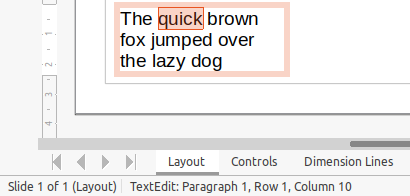
Figure 5: Line and Filling toolbar

By default, when a text box is created, the borders of the text box are only displayed when the text box is selected. If necessary, use one of the following methods to create a visible border around the text box.
1) Click on a text box to select it so that the border is displayed indicating that the text box is in edit mode.
2) In Line Style on the Line and Filling toolbar (Figure 5), select a line style from the drop‑down list to use as a text box border. If the Line and Filling toolbar is not visible, go to View > Toolbars > Line and Filling on the Menu bar.
3) In Line Width on the Line and Filling toolbar, enter a width for the line style selected for the text box border.
4) In Line Color on the Line and Filling toolbar, select a color from one of the available color palettes, or create a custom color.
5) Click outside the text box to exit edit mode.
1) Click on a text box to select it so that the border is displayed indicating that the text box is in edit mode.
2) Open the Line dialog (Figure 6) using one of the following methods:
Right-click on the text box border and select Line from the context menu.
Go to Format > Line on the Menu bar.
3) Click on Line to open the Line page.
4) In Style, select a line style from the drop-down list to use as a text box border.
5) In Color, select a color for the line style from one of the available color palettes, or create a custom color.
6) In Width, enter a width for the line style selected.
7) If necessary, in Transparency and enter a percentage value for the line style.
8) If necessary, in Corner Style, select the type of corner style from the options in the drop‑down list.
9) Click OK to save the changes and close the Line dialog.
10) Click outside the text box to exit edit mode.
Note
For a corner style to be clearly visible in a text box border, it is recommended to set the line width at a thickness above 0.35cm, as shown by the example in Figure 7.
Figure 6: Line dialog - Line page for creating text box border

Figure 7: Example of a text box border with rounded corners

Figure 8: Line panel in Properties deck on Sidebar
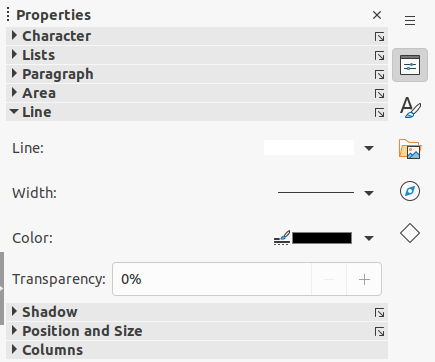
1) Click on a text box to select it so that the border is displayed indicating that the text box is in edit mode.
2) Click on Properties to open the Properties deck in the Sidebar, then click on Line to open the Line panel (Figure 8).
3) In Line, select a line style from the drop-down list to use as a text box border.
4) In Width, enter a width for the line style selected.
5) In Color, select a color for the line style from one of the available color palettes, or create a custom color.
6) If necessary, in Transparency and enter a percentage value for the line style.
7) Click outside the text box to exit edit mode.
1) Click on the text in a text box to activate the text mode and the text box border is displayed.
2) Move the cursor over the border. The cursor changes shape to the move symbol for the computer setup (for example, a clenched hand).
3) Click on the border and drag the text box to a new position in the drawing. A ghosted outline of the text box shows where it will be placed (Figure 9).
4) Release the cursor when the text box is in the required position.
5) To accurately position a text box, use the Position and Size dialog or the Position and Size panel in the Properties deck on the Sidebar. See Chapter 3, Working with Objects for more information.
6) When the text box is in the required position, click outside the text box to save the changes and deselect the text box.
Figure 9: Moving a text box
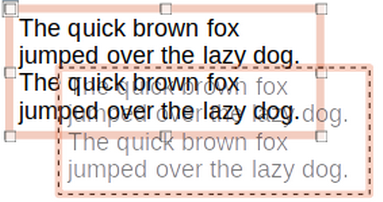
Figure 10: Resizing a text box
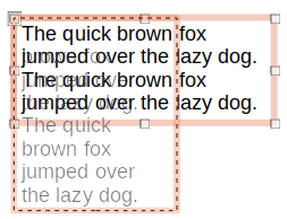
1) Click on the text in a text box to activate text mode and a text box border is displayed.
2) Move the cursor over one of the selection handles. The cursor changes shape to the resizing symbol for the computer setup (for example, a double-headed arrow). The selection handles are used to resize the text box as follows:
Corner handles change the width and height of the text box simultaneously.
Top and bottom selection handles change the height of the text box.
Right and left selection handles change the width of the text box.
3) Click and drag the border to a new position to resize the text box. A ghosted outline of the text box shows is displayed as the text box is resized (Figure 10).
4) Release the cursor when the text box reaches the desired size.
5) To accurately resize a text box, use the Position and Size dialog or the Position and Size panel in the Properties deck on the Sidebar. See Chapter 3, Working with Objects for more information.
6) When the text box is at the required size, click outside the text box to save the changes and deselect the text box.
Note
Press and hold the Shift key to maintain text box proportions, then click and drag a selection handle to resize. Release the cursor before releasing the Shift key.
1) Click on the text in a text box to activate text mode and a text box border is displayed.
2) Click on the text box border so that the selection handles are visible indicating that the text box is now in edit mode.
3) Click again on the text border and the selection handles change shape and color.
4) Click on a corner selection handle and drag to rotate the text box. A ghosted outline of the text box being rotated appears and the current angle of rotation is shown in the status bar (Figure 11).
5) Release the cursor when the text box is at the desired rotation angle.
6) To accurately rotate a text box, use the Rotation page in Position and Size dialog or the Position and Size panel in the Properties deck on the Sidebar. See Chapter 3, Working with Objects for more information.
Figure 11: Rotating text box
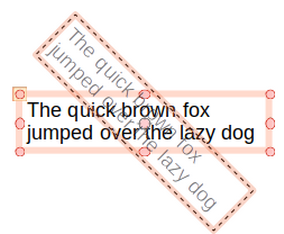
Note
When in rotation mode, the top, bottom, and side selection handles, though visible, are not available for use for rotating a text box. Also, text boxes cannot be sheared, slanted, flipped vertically, or flipped horizontally.
Text boxes can be treated just like other basic shapes in a drawing when formatting the area fill or borders of a box. See Chapter 3, Working with Objects for more information on formatting the area fill or borders of a text box.
After formatting text to match the drawing requirements, format a text box as follows so that text appears correctly inside a text box:
1) Select a text box and use one of the following methods to open the Text dialog (Figure 12).
Right-click on the text box and select Text Attributes from the context menu.
Go to Format > Text Attributes on the Menu bar.
2) Click on Text in the Text dialog to open the Text page and access to the formatting options:
Drawing Object Text –– Fit width to text –– expands or contracts the width of the text box to the length of the text, if the text box is smaller or larger than the text. Can be used with Fit height to text to automatically adjust width and height of the text box to the text.
Drawing Object Text –– Fit height to text –– expands or contract the height of the text box to the height of the text, if the text box is smaller or larger than the text. Can be used with Fit width to text to automatically adjust width and height of the text box to the text.
Figure 12: Text dialog for text boxes - Text page
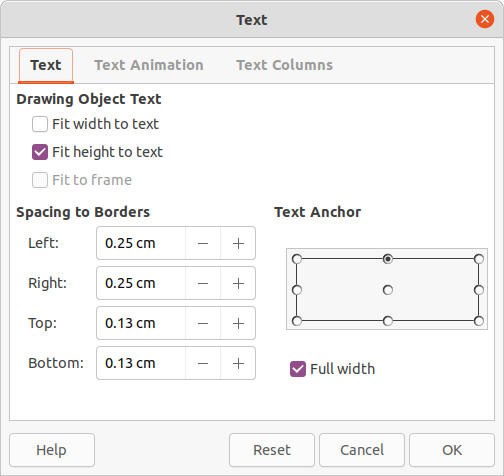
Drawing Object Text –– Fit to frame –– resizes (distorts) the text to fit the entire area of the text box, but does not change the width or height of the text box. This option is not available if Fit width to text and/or Fit height to text options are selected.
Spacing to Borders – specify the amount of space to leave between the text and the borders of the text box.
Text Anchor – anchors the text to one of nine positions within the text box. The left and right anchor positions can only be selected when Full width is not selected. A text anchor only determines the position of the text within the text box and does not change the paragraph alignment of the text inside the text box.
Full width –when selected, the text box width expands to fit the longest paragraph of text inside the text box as a single line. When selected, only the top, middle or bottom center positions in Text Anchor can be used to anchor the text inside the text box.
Note
Text animation is not recommended text in a drawing unless the drawing is going to be displayed as part of a presentation. See the Impress Guide for more information on text animation.
3) If required, click on Text Animation to open the Text Animation page (Figure 13) to access options for animating the text.
4) If required, click on Text Columns to open the Text Columns page (Figure 14) to access the options for creating columns in a text box as follows. For more information on using text columns in a drawing, see “Text columns” on page 1.
a) Enter the number of columns required in the Number of columns box.
b) Enter the required spacing between columns in the Spacing box.
5) Click OK to save the changes to text attributes and close the Text dialog.
6) Move the cursor away from the text box, then click to end the text mode.
Figure 13: Text dialog for text boxes - Text Animation page
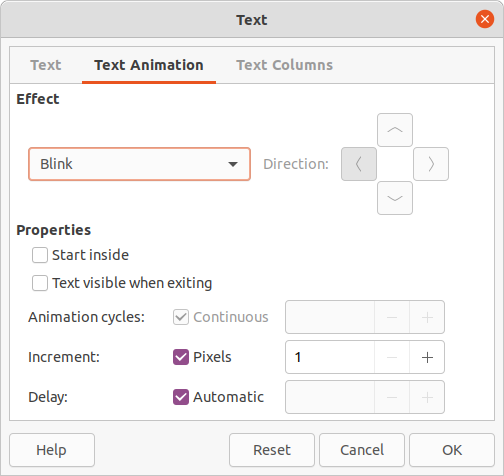
Figure 14: Text dialog for text boxes - Text Columns page
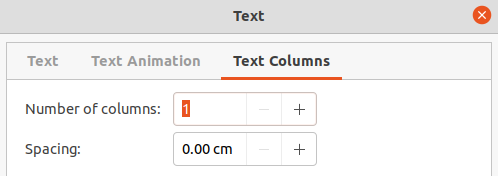
1) Click on the text box so that the selection handles are visible indicating that the text box is in edit mode.
2) Press the Delete or Backspace key. The text box is deleted without any warning.
Text can be added to most Draw objects. The exceptions are control elements, for example buttons, or 3D objects.
By default, an object is not dynamic when it is first created in Draw and does not behave like a text box. By default, text does not word wrap inside an object. To keep text within the borders of an object, use word wrap, paragraphs, line breaks, smaller text size, increasing object size, or a combination of all methods. Actual method method available depends on the type of Draw object selected.
An example of adding text into a Draw object is shown in Figure 15. The left object does not have the word wrap option applied and the right object has the word wrap option applied.
1) Create an object in a drawing and make sure the object is selected with the selection handles displayed.
2) Enter text mode on the selected object using one of the following methods:
Click on Insert Text Box for horizontal text or Insert Vertical Text for vertical text on the Standard, Drawing, or Text toolbars.
For horizontal text, double-click on the selected object.
For horizontal text, use the keyboard shortcut F2.
For vertical text, double-click on the selected object and click on Insert Vertical Text on the Standard or Drawing toolbar.
3) Type or paste text into the selected object.
Figure 15: Example of using word wrap
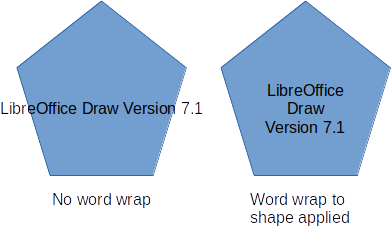
Figure 16: Text dialog for text in objects – Text page
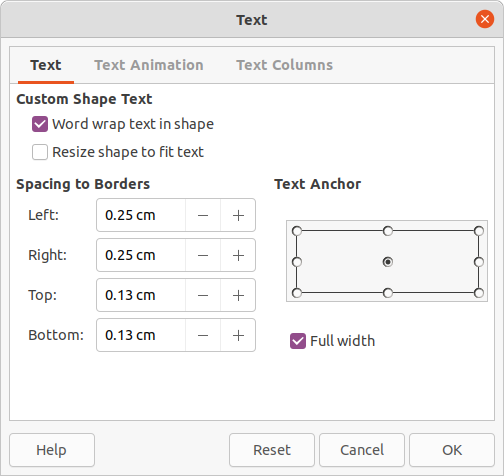
4) Format the text using the various tools on the Text Formatting toolbar, the panels in the Properties deck on the Sidebar, or the options in Format on the Menu bar. For more information on text formatting, see “Formatting text” on page 1.
5) If the text goes outside the object borders, click on Text in the Text dialog to open the Text page (Figure 16) and access to the formatting options:
Custom Shape Text –– Word wrap text in shape –– wraps the text so that it fits inside the object. For example, if the width of the object is changed, then the height of the object either increases or decreases to accommodate the increase or decrease in the number of lines of text.
Custom Shape Text –– Resize shape to fit text –– resizes the object to fit the text that is being entered into the object. For example, if the object already contains one multi-line paragraph of text and this option is selected, then the object width expands and the height decreases until the text is a single line of text.
Spacing to Borders – specify the amount of space to leave between the text and the borders of the object.
Text Anchor – anchors the text to one of nine positions within the text box. The left and right anchor positions can only be selected when Full width is not selected. A text anchor only determines the position of the text within the text box and does not change the paragraph alignment of the text inside the object.
Full width – when selected, the object width expands to fit the longest paragraph of text inside the object as a single line. When selected, only the top, middle or bottom center positions in Text Anchor can be used to anchor the text inside the text box.
6) If required, click on Text Animation to open the Text Animation page (Figure 17) to access options for animating the text.
Note
Text animation is not recommended text in a drawing unless the drawing is going to be displayed as part of a presentation. See the Impress Guide for more information.
Figure 17: Text dialog for objects - Text Animation page
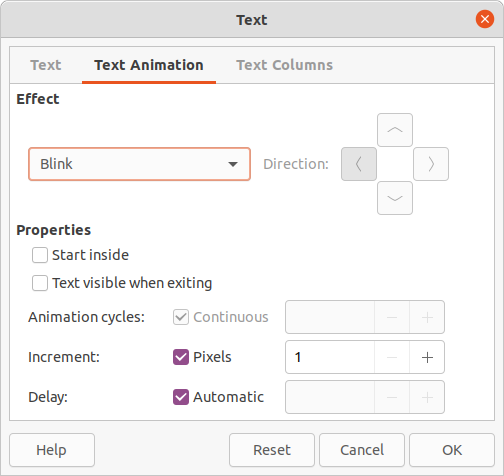
Figure 18: Text dialog for objects - Text Columns page
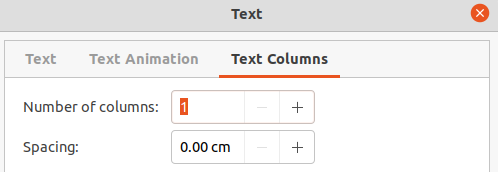
7) If required, click on Text Columns to open the Text Columns page (Figure 18) to access the options for creating columns in a text box as follows. For more information on using text columns in a drawing, see “Text columns” on page 1.
a) Enter the number of columns required in the Number of columns box.
b) Enter the required spacing between columns in the Spacing box.
8) Click OK to save the changes to text attributes in the object and close the Text dialog.
9) Move the cursor away from the object, then click to end the text mode.
Text may be inserted into a text box or object by copying text from another object or document and pasting into a drawing.
Note
When using Format > Paste on the Menu bar, or the keyboard shortcut Ctrl+V (macOS ⌘+V) to paste copied text directly into a drawing and not into an object, the text is pasted as an OLE object and not as a Draw object. It is recommended to paste text into Draw as unformatted text to create a text object in Draw.
Figure 19: Paste Special dialog
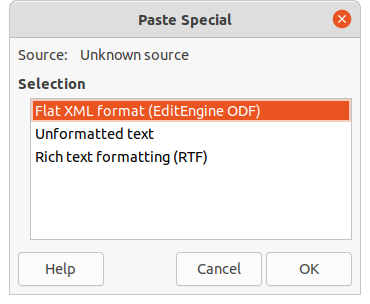
Pasted text retains the formatting from the source document and may not match the formatting of the text that has already been used on a drawing. It is good practice to paste text without formatting and apply the formatting later to match any text already in a drawing.
1) Copy the text and paste it as unformatted text into a drawing using one of the following methods:
Go to Edit > Paste Special > Paste Unformatted Text on the Menu bar.
Go to Edit > Paste Special > Paste Special on the Menu bar and the Paste Special dialog (Figure 19) opens. Select the option Unformatted text and click OK to close the dialog.
Use the keyboard shortcut Control+Shift+V (macOS ⌘+Shift+V) and the Paste Special dialog opens. Select the option Unformatted text and click OK to close the dialog.
Click on the triangle ▼ on the right of Paste on the Standard toolbar and select Unformatted text from the context menu.
2) The unformatted text is pasted into a text box at the cursor position or inside a selected object and formatted to the default drawing style. Format the pasted text to the drawing requirements or apply a drawing style. For more information, see “Formatting text” below.
Text formatting can give a drawing a more consistent and professional look without any distracting elements. Text formatting tools are available on the Text Formatting toolbar and drop‑down menus in Format on the Menu bar. For more information on text formatting, see the Writer Guide.
If there are several text boxes and/or objects in a drawing that require the same text formatting, it is recommended to use drawing styles. For more information on using and creating styles, see Chapter 4, Changing Object Attributes.
After selecting text, the font size can be quickly increased or decreased using the tools Increase Font Size (Ctrl+]) (macOS ⌘+]) and Decrease Font Size (Ctrl+[) (macOS ⌘+[) on the Text Formatting toolbar. The amount by which the font size changes depends on the standard sizes available for the font in use.
Text must be selected before it can be formatted using one of the following methods. Any formatting changes apply only to the selected text.
To format all the text in a text box or object, click once on the border of the text box or object to display the selection handles. Any formatting changes then apply to all text in the text box or object.
To format only part of the text, select text using one of the following methods:
Click in the text and drag the cursor over the text to highlight the text.
Double-click on text to select a complete word or triple-click to select a whole paragraph.
Click in the text, then press and hold the Shift key and use the keyboard arrow keys to select text.
Text formatting can be applied directly to characters, words, sentences, and paragraphs. Direct formatting to text overrides any formatting that has been applied using styles.
1) Select the text for formatting and format using one of the following methods:
Various formatting tools on the Text Formatting toolbar.
Go to Format on the Menu bar and select a formatting option from the drop-down menu. Selecting a formatting option opens either a context menu or a dialog providing further formatting options to apply to the selected text.
Use the options in the Paragraph and Character dialogs.
Use the options in the Paragraph and Character panels in the Properties deck on the Sidebar.
2) Click outside the text box or object to deselect the text.
The Paragraph dialog (Figure 20) is used to format paragraphs of text.
1) Click anywhere in the paragraph that is to be formatted.
2) Use one of the following methods to open the Paragraph dialog.
Right-click on the selected text and select Paragraph from the context menu.
Go to Format > Paragraph on the Menu bar.
3) Use the various options on the tabbed pages of the Paragraph dialog to format the text.
4) Click OK to save the changes and close the Paragraph dialog.
5) Click outside the text box or object to deselect the text.
Note
For information on the various formatting options available for text in the pages of the Paragraph dialog, refer to the Writer Guide.
Figure 20: Paragraph dialog - Indents & Spacing page
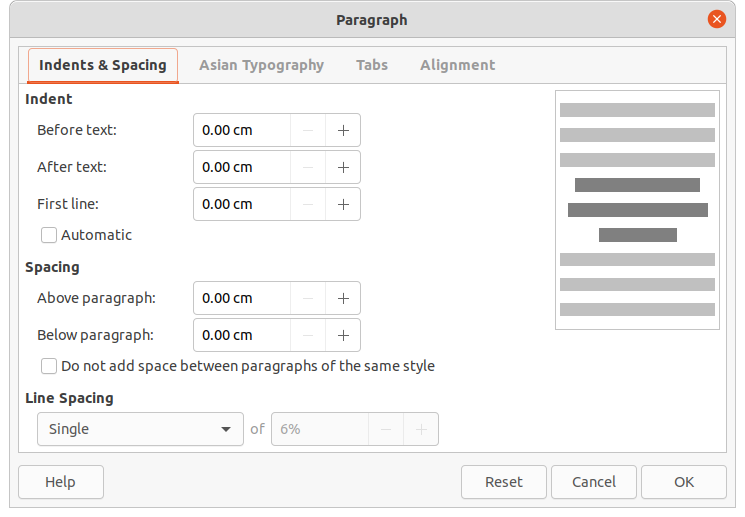
Figure 21: Paragraph panel in Properties deck on Sidebar
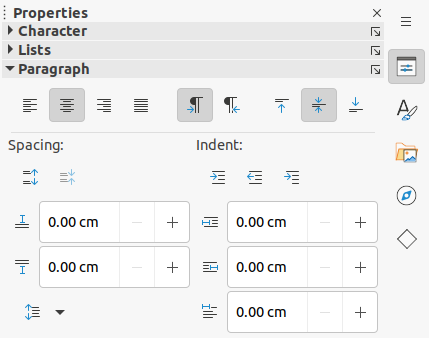
An alternative method of formatting paragraphs is to use the Paragraph panel (Figure 21) in the Properties deck on the Sidebar. The formatting options are limited, but are similar in use to the formatting options in the various pages of the Paragraph dialog. Any formatting applied to a paragraph using the Sidebar is immediate.
1) Click anywhere in the paragraph that is to be formatted.
2) On the Sidebar, click on Properties to open the Properties deck.
3) If necessary, click on the expansion symbol on the left of the Paragraph title bar to open the Paragraph panel.
4) Format the text using the various tools in the Paragraph panel. See “Paragraph dialog” on page 1 for more information on formatting options.
5) If necessary, click on More Options on the right of the title bar to open the Paragraph dialog to format text.
Note
For information on the various formatting options available for text in the Paragraph panel on the Sidebar, refer to the Writer Guide.
Direct or manual character formatting can be applied to individual characters and words. Direct character formatting overrides any formatting that has been applied using direct text formatting and drawing styles.
1) Select the characters for formatting, see “Selecting text” on page 1 for more information.
2) Format characters using one of the following methods.
Various formatting tools on the Text Formatting toolbar. Formatting applied to character(s) is immediate.
Go to Format on the Menu bar. Selecting a formatting option opens either a context menu or dialog where further formatting options are selected.
Use the options available in the Character dialog. Clicking OK on the dialog applies the formatting changes.
Use the options available in the Character panel in the Properties deck on the Sidebar. Formatting applied to character(s) is immediate.
3) Click outside the text box or object to deselect the text.
1) Select the characters for formatting and open the Character dialog (Figure 22) using one of the following methods:
Right-click on the characters and select Character from the context menu.
Go to Format > Character on the Menu bar.
2) Use the options on the tabbed pages of the Character dialog to format the selected characters.
3) Click OK to apply the formatting changes and close the dialog.
4) Click outside the text box or object to deselect the text.
Note
For information on the various formatting options available for characters in the pages of the Character dialog, refer to the Writer Guide.
Figure 22: Character dialog - Fonts page
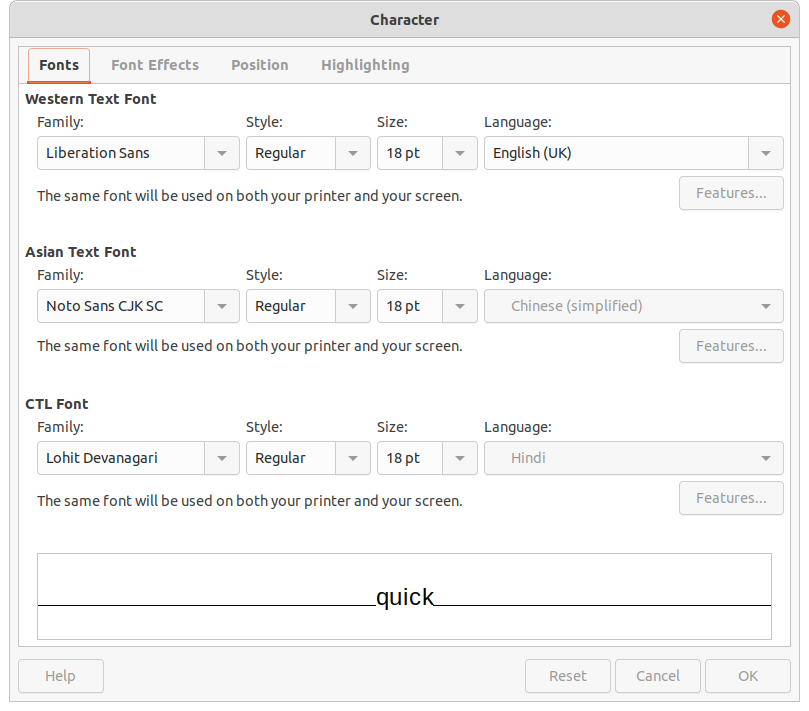
Figure 23: Character panel in Properties deck on Sidebar
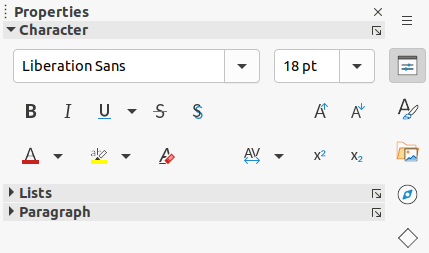
An alternative method of formatting text is to use the Character panel (Figure 23) in the Properties deck on the Sidebar. The formatting options available in the Character panel are limited, but are similar in use to the formatting options available in the various pages of the Character dialog. Most of the options are also available on the Text Formatting toolbar.
1) Select a text box or object so that the selection handles on the border are displayed.
2) On the Sidebar, click on Properties to open the Properties deck.
3) Click on the expansion symbol on the left of the Character title bar to open the Character section.
4) Format the text using the tools in the Character panel. See “Character dialog” on page 1 for more information on formatting options.
5) If necessary, click on More Options on the right of the title bar to open the Character dialog to format text.
Note
For information on the various formatting options available for characters in the Character panel on the Sidebar, refer to the Writer Guide.
Unordered (bulleted) and ordered (numbered) lists can be created in text boxes and objects. However, when creating lists in objects, please remember that Draw objects are not dynamic and do not automatically expand as a list is created.
Note
Creating unordered or ordered lists in Draw is similar to LibreOffice Writer. For more information on unordered or ordered lists, see the Writer Guide.
Figure 24: Lists panel in Properties deck on Sidebar
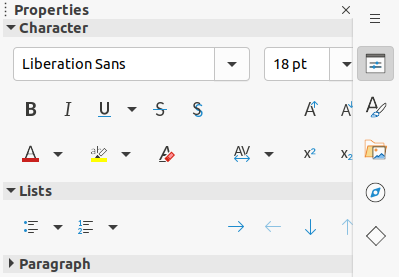
Figure 25: More Bullets list
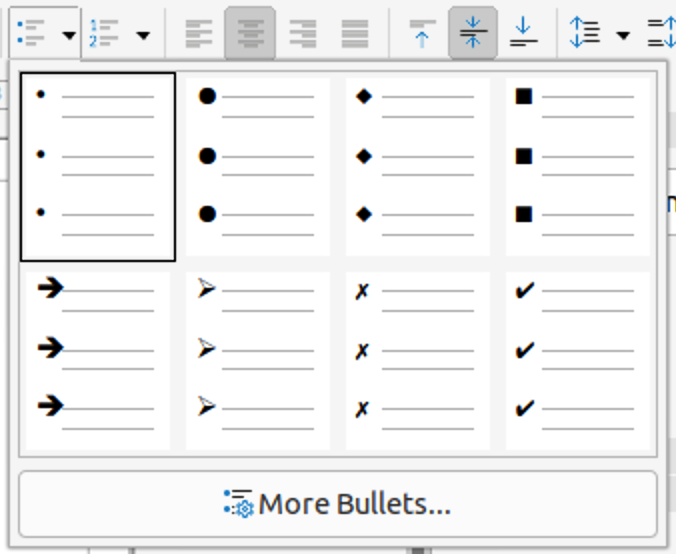
Figure 26: More Numbering lists
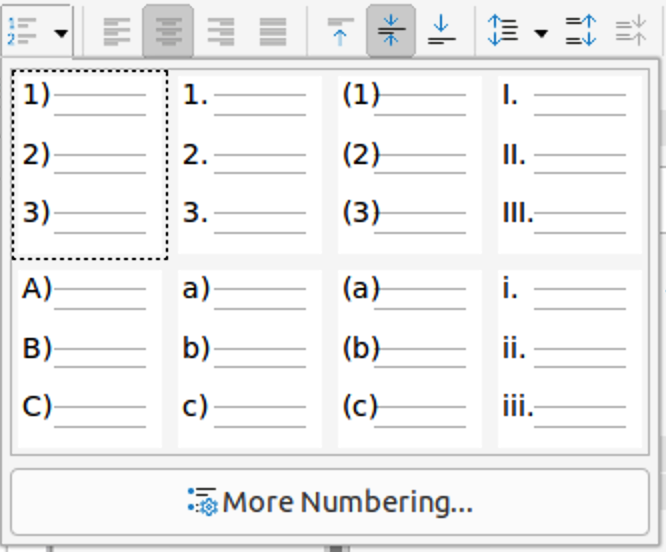
Unordered or ordered lists can be created in text boxes or Draw objects as follows:
1) Select all of the text required for a list.
2) Create a list using one of the following methods and default settings for lists:
Click on Toggle Unordered List or Toggle Ordered List on the Text Formatting toolbar.
Click on Toggle Unordered List or Toggle Ordered List in the Lists panel in the Properties deck on the Sidebar (Figure 24).
Go to Format > Lists > Unordered List or Ordered List on the Menu bar.
3) To change the format of the list, click on the triangle ▼ on the right of the list icons and select a list style from the options available in the pop-up More Bullets dialog (Figures 25) or More Numbering dialog (Figure 26).
Each item in an unordered or ordered list can have its level demoted or promoted within a list, or moved up or down in list order as follows:
1) Click on a list item to demote, promote, or move up or down.
2) To demote a list item one level at a time, use one of the following methods:
Use the Tab key.
Go to Format > Lists > Demote on the Menu bar.
Use Demote in the Lists panel in the Properties deck on the Sidebar.
3) To promote a list item one level at a time, use one of the following methods:
Use the key combination Shift+Tab.
Go to Format > Lists > Promote on the Menu bar.
Use Promote in the Lists panel in the Properties deck on the Sidebar.
4) To change the position of a list item in the list order, use one of the following methods:
Go to Format > Lists > Move Up or Move Down on the Menu bar.
Use Move Up or Move Down in the Lists panel in the Properties deck on the Sidebar.
Figure 27: Bullets and Numbering dialog
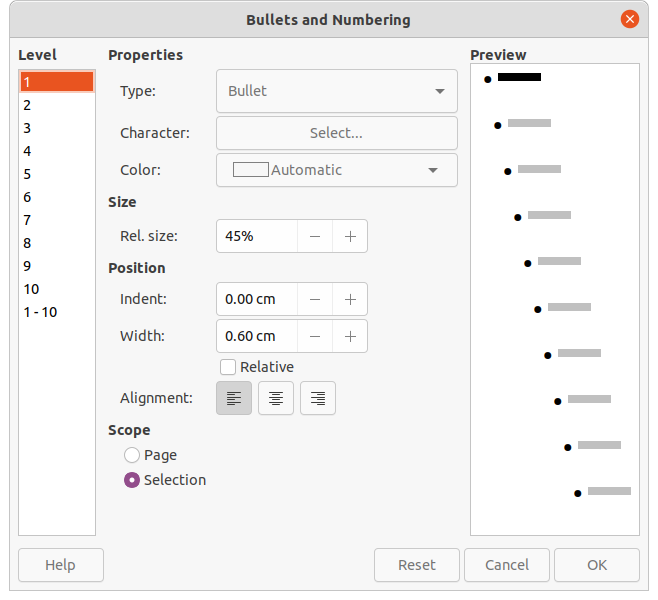
Use the Bullets and Numbering dialog (Figure 27) for more control over the format of a list. Select text in a text box or object and open the dialog using one of the following methods:
Go to Format > Bullets and Numbering on the Menu bar.
Right-click on the selected text and select Bullets and Numbering from the context menu.
Click on More Options on the right side of Lists panel title bar in the Properties deck on the Sidebar.
Click on More Bullets or More Numbering after clicking on the triangle ▼ on the right of Toggle Unordered List or Toggle Ordered List on the Text Formatting toolbar or in the Lists panel in the Properties deck on the Sidebar.
Note
For more information on the options available in the Bullets and Numbering dialog for unordered or ordered lists, see the Writer Guide.
Text in a drawing can be formatted into columns inside text boxes and objects. However, columns cannot be used on separate parts of text inside a text box or object. The whole of the text box or object has to be used for columns.
The type of columns used in Draw are continuous flow columns. This means that when text reaches the bottom of a column it will automatically flow into the next column as text is added. This column type is also known as newspaper columns.
1) Click the border of a text box to select it so that the selection handles are displayed indicating that the text box is in edit mode.
2) Open the options for text columns using one of the following methods:
Right-click in the text box and select Text Attributes from the context menu to open the Text dialog, the click on the Text Columns tab to open the Text Columns page (Figure 28),
Click on Columns in Properties on the Sidebar to open the Columns panel (Figure 29).
3) Set the number of columns required in the Number of columns box and the required spacing between the columns in the Spacing box.
4) Save the changes and deselect the text box using one of the following methods:
For the Text dialog, click OK to save the changes and close the dialog, then click outside the text box to deselect it.
For the Columns panel in the Properties deck on the Sidebar, click outside the text box to deselect it and save the changes.
Note
Any text inside a text box or drawing object automatically flows into column format when the changes are saved.
Figure 28: Text dialog - Text Columns page

Figure 29: Columns panel in Properties deck on Sidebar
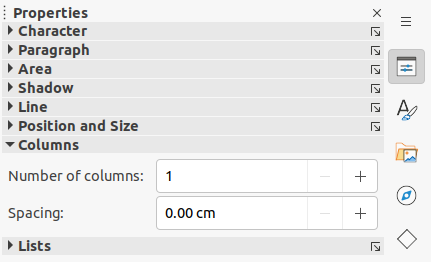
1) Click on an object to select it so that the selection handles are displayed indicating that the object is in edit mode.
2) Double-click on the selected object to switch on text edit mode.
3) Open the options for text columns using one of the following methods:
Right-click in the drawing object and select Text Attributes from the context menu to open the Text dialog, the click on the Text Columns tab to open the Text Columns page (Figure 28),
Click on Columns in Properties on the Sidebar to open the Columns panel (Figure 29).
4) Set the number of columns required in the Number of columns box and the required spacing between the columns in the Spacing box.
5) Save the changes and deselect the object using one of the following methods:
For the Text dialog, click OK to save the changes and close the dialog, then click outside the object to deselect it.
For the Columns panel in the Properties deck on the Sidebar, click outside the object to deselect it and save the changes.
6) Double-click again on the object to switch on text edit mode.
7) Type in the required text or use copy and paste to enter the required text. Any text entered will be in column format.
8) If necessary, format the text to the drawing requirements.
9) Click outside the object to deselect it and save the changes.
A text callout is a short line of text connected by a line to highlight or point out a feature of an illustration or drawing, and give information about that feature as shown by the example in Figure 30. Two types of text callouts are available –– Callouts for horizontal text and Vertical Callouts for vertical text.
The text callouts in LibreOffice Draw are a legacy from the first versions of LibreOffice and are available on the Text toolbar (Figure 3 on page 1). They can also be installed on other toolbars, for example Standard or Line toolbar. For more information on customizing toolbars, see Appendix B, Toolbars or the Getting Started Guide.
Figure 30: Example of using text callouts
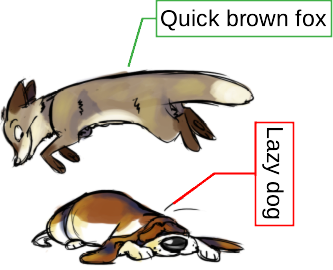
Note
Newer custom shape callouts can be found by selecting Callout Shapes on the Drawing toolbar, or the Callouts panel in the Shapes deck on the Sidebar. These custom shape callouts have the same purpose as text callouts, but have different options available. For more information on custom shape callouts, see Chapter 2, Drawing Basic Shapes, Chapter 3, Working with Objects, and Chapter 4, Changing Object Attributes.
1) Click on Callouts for horizontal text, or Vertical Callouts for vertical text on the Text toolbar.
2) Click in the drawing and drag the cursor to create the callout.
3) Double click in the callout box to enter text mode.
4) Type the required text, then click in a blank space in the drawing. The callout box adjusts its size horizontally and/or vertically to fit the text within the callout box.
5) Select the callout and click on the selection handle at the end of the connector line, then drag the end of the connector line to the required position.
6) With the callout still selected, click on the callout box and drag it to the required position.
7) Click in a blank space in the drawing to deselect the text callout and save the changes.
1) Double click in the callout box to enter text mode and, if required, edit and format the text. See “Formatting text” on page 1 for more information on text formatting.
2) Click in a blank space in the drawing to save the changes to the text.
Figure 31: Position and Size dialog –– Callouts page
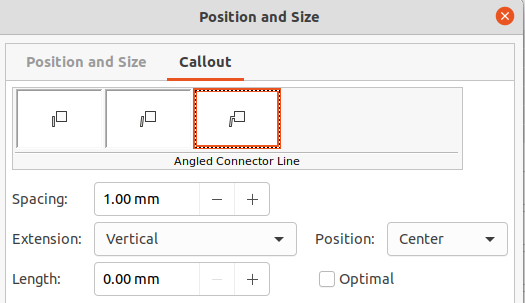
3) Select the text callout so that the selection handles are displayed.
4) Right click on the selected text callout and select an option from the context menu to change the attributes for position, size, line, and area of the text callout. For more information, see Chapter 3, Working with Objects, and Chapter 4, Changing Object Attributes.
5) Click on the selection handle at the end of the connector line and drag it to change the position of the line end or the length of the connector line.
6) Select the text callout and open the Position and Size dialog (Figure 31) using one of the following methods:
Right-click on the selected callout and select Position and Size from the context menu.
Go to Format > Position and Size on the Menu bar.
Use the keyboard shortcut F4.
Note
The Callout page in the Position and Size dialog shown in Figure 31 is only available when a text callout has been selected. It is not available for Callout Shapes that are available on the Drawing toolbar, or in the Callouts panel in the Shapes deck on the Sidebar
7) Click on the Callout tab to open the formatting options available for text callouts.
8) In Callout Styles, select the style of text callout from Straight Line, Angled Line, or Angled Connector Line.
9) In Spacing, enter the amount of space required between the end of the callout line and the callout box.
10) In Extension, select from the drop-down list how the callout line from extends the callout box.
11) In the By text box, enter a distance value to create a space between the start point of the connector line and the callout box.
12) In Length, enter the length of the callout line segment that extends from the callout box to the angle point of the connector line.
Note
The Length option is only available if Angled Connector Line is selected as callout style and the Optimal check box is not selected.
13) In Optimal, select this option to display the angle point in a connector line at an optimal distance from the callout box.
14) Click in a blank space in the drawing to deselect the text callout and save the changes.
Tables are a powerful mechanism to convey structured information quickly when used in a drawing. Tables can be added directly to a drawing eliminating the need to embed a Calc spreadsheet or a Writer text table. However, in some circumstances, it makes sense to embed a spreadsheet into a drawing, especially when greater functionality is required in the table. The tables provided by Draw do have a limited functionality.
Tables are placed at the center of a drawing and cannot be placed into objects or shapes. Also, unlike text boxes and other objects, tables cannot be rotated.
Figure 32: Insert Table dialog
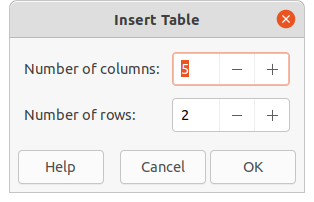
Figure 33: Table grid
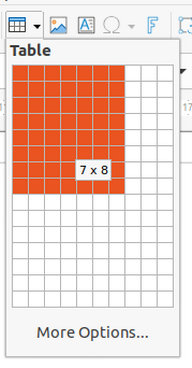
1) To create and insert a table using the Insert Table dialog (Figure 32):
a) Go to Insert > Table on the Menu bar to open the Insert Table dialog.
b) Enter the number of rows and columns required.
c) Click OK to insert the table into the center of a drawing and close the dialog.
2) Alternatively, to create and insert a table using the Table grid (Figure 33):
a) Click on Table on the Standard toolbar to open the Table grid.
b) Click and drag the cursor until the required number of columns and rows are selected,
c) Click again to insert the table into the center of a drawing and close the Table grid.
d) If necessary, click on More Options to open the Insert Table dialog to select the number of rows and columns required.
3) Move the table into position by clicking on the border and dragging it to its new position.
Note
When inserting tables into a drawing, the table is created using the default style with settings already applied. Currently these defaults are hard coded in LibreOffice. The table can be formatted to the drawing requirements after insertion.
Several predefined table designs are provided in the Table Design panel in the Properties deck on the Sidebar (Figure 34). The Table Design panel is only available when a table is selected.
1) Insert a table into a drawing or select a table in a drawing.
2) Click on Table Design in the Properties deck on the Sidebar to open the Table Design panel, or click on Table Design on the Table toolbar.
3) Select a design for the table and the types of rows and columns from the available options.
Figure 34: Table Design panel in Properties deck on Sidebar
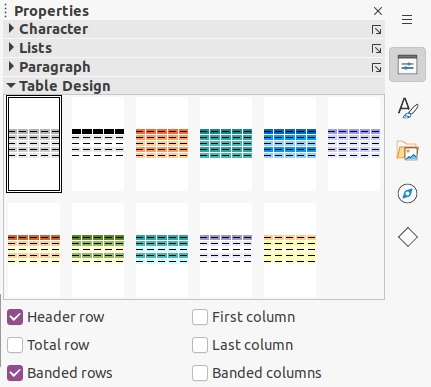
The following options for rows and columns are available in the Table Design panel:
Header row – selected by default. The first row is normally a header row and is displayed with a different background from the rest of the table.
Total row – if selected, changes the background of the last row to make it stand out from other rows.
Banded rows – selected by default. Alternate rows have different backgrounds making it easier to read data entered into the rows.
First column – when selected, highlights the first column of the table using a darker background.
Last column – when selected, highlights the last column of the table using a darker background.
Banded columns – when selected, alternate columns are highlighted with dark and light colors.
After inserting a table, it can be formatted using the tools and options available on the Table toolbar, by going to Format > Table on the Menu bar, or using the options available in the Table Properties dialog.
The Table toolbar (Figure 35) automatically opens when a table is selected providing tools for creating and formatting a table. The default position for the toolbar, when it is first opened, is docked at the bottom of the Workspace.
Figure 35: Table toolbar

Table – inserts a new table in a drawing using the Insert Table dialog or the Table grid. See “Inserting tables” above for more information on inserting tables.
Border Style – changes the line style of the borders of selected cells. Click on the triangle ▼ next to the icon to open a drop-down list and select from a range of predefined styles.
Border Color – changes the color of the borders of selected cells. Click on the triangle ▼ next to the icon to open access to the LibreOffice color palettes. Select a color from a range of predefined palettes or create a custom color.
Borders – selects a predefined border configuration for the selected cells. Click on the triangle ▼ next to the icon to open a drop-down list to select a border configuration.
Area Style/Filling – select the cells to be filled, then select the type of fill from the drop‑down list: None, Color, Gradient, Hatching, Bitmap or Pattern.
Fill Color – select a fill option from the drop-down menu. The fill options change to show the fillings available for each Area Style/Filling type.
Merge Cells – merges the selected cells into one cell. Note that the contents of the merged cells are also merged. Alternatively, right-click on selected cells and select Merge Cells from the context menu.
Split Cells – splits a selected cell into multiple cells either horizontally or vertically. Make sure that the cursor is positioned on the cell, then click on Split Cells to open the Split Cells dialog (Figure 36).
In the Split Cells dialog, select the number of cells required when splitting a cell and whether to split the cell horizontally or vertically. If necessary, when splitting horizontally, select Into equal proportions to create cells of equal size. The contents of the split cell are kept in the original cell (left or top cell).
Figure 36: Split Cells dialog
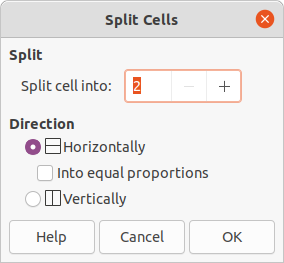
Optimize – evenly distributes the selected rows and columns in a table either horizontally or vertically. Clicking on Optimize opens the Optimize toolbar (Figure 37) which contains the following tools:
Minimal Row Height – determines the minimal row height for selected rows. Minimal row height depends on the font size of the smallest character in the row.
Minimal Column Width – defines the minimal column width for selected columns. Minimal column width depends on the shortest entry within a column.
Optimal Row Height – determines the optimal row height for selected rows. Optimal row height depends on the font size of the largest character in the row.
Optimal Column Width – defines the optimal column width for selected columns. Optimal column width depends on the longest entry within a column.
Distribute Rows Equally – adjusts the height of the selected rows to match the height of the tallest row in the selection.
Distribute Columns Evenly – adjusts the width of the selected columns to match the width of the widest column in the selection. The total width of the table cannot exceed the width of the page.
Figure 37: Optimize toolbar

Align Top, Center Vertically, Align Bottom – sets the vertical alignment of text in selected cells.
Insert Row Above, Insert Row Below – click in a cell or cells to select rows and use these two tools to insert a row or rows above or below the selected rows. Alternatively, right‑click on the selected rows and select Insert > Insert Row Above or Insert Row Below.
Insert Column Before, Insert Column After – click in a cell or cells to select columns and use these two tools to insert a column or columns before or after the selected columns. Alternatively, right‑click on the selected columns and select Insert > Insert Column Before or Insert Insert Column After.
Delete Row, Delete Column, Delete Table – click in a cell or cells to select rows or columns, then click on a tool to delete the selected rows or columns. To delete the whole table, place the cursor in a cell and select Delete Table. Alternatively, right-click on the selected cells and select Delete > Delete Row or Delete Column or Delete Table from the context menu.
Select Table, Select Column, Select Row – select a table, column, or row if the same attributes are going to be applied to a table, column, or row.
Table Design – click on this tool and open the Table Design panel in the Properties deck on the Sidebar. See “Table Design panel” on page 1 for more information.
Table Properties – click on this tool and open the Table Properties dialog. Alternatively, right-click on the table and select Table Properties from the context menu.
Table formatting tools are also available by going to Format > Table on the Menu bar and selecting a formatting option from the submenu that opens.
Minimal Row Height – determines the minimal row height for selected rows. Minimal row height depends on the font size of the smallest character in the row.
Optimal Row Height – determines the optimal row height for selected rows. Optimal row height depends on the font size of the largest character in the row.
Distribute Columns Evenly – adjusts the width of the selected columns to match the width of the widest column in the selection. The total width of the table cannot exceed the width of the page.
Select Row – selects the row or rows where cells have been selected in the table.
Insert Rows – inserts rows in the table where cells have been selected in the table.
Delete Row – deletes rows in the table where cells have been selected in the table.
Minimal Column Width – defines the minimal column width for selected columns. Minimal column width depends on the shortest entry within a column.
Optimal Column Width – defines the optimal column width for selected columns. Optimal column width depends on the longest entry within a column.
Distribute Columns Evenly – adjusts the width of the selected columns to match the width of the widest column in the selection. The total width of the table cannot exceed the width of the page.
Select Column – selects the column or columns where cells have been selected in the table.
Insert Columns – inserts columns in the table where cells have been selected in the table.
Delete Column – deletes columns in the table where cells have been selected in the table.
Merge Cells – merges the selected cells into one cell. Note that the contents of the merged cells are also merged. Alternatively, right-click on selected cells and select Merge Cells from the context menu.
Split Cells – splits a selected cell into multiple cells either horizontally or vertically. Make sure that the cursor is positioned on the cell, then click on Split Cells to open the Split Cells dialog.
Delete Table – to delete the whole table, place the cursor in a cell and select Delete Table. Alternatively, right-click on the selected cells and select Delete Table from the context menu.
Select... – selects the whole table.
Properties… – opens the Table Properties dialog.
The Table Properties dialog has five tabbed pages that provide formatting options for Font, Font Effects, Borders, Background, and Shadow. To open the Table Properties dialog use one of the following methods:
Right-click in a table and select Table Properties from the context menu.
Go to Format > Table > Properties on the Menu bar.
Click on Table Properties on the Table toolbar.
Figure 38: Table Properties dialog - Font page
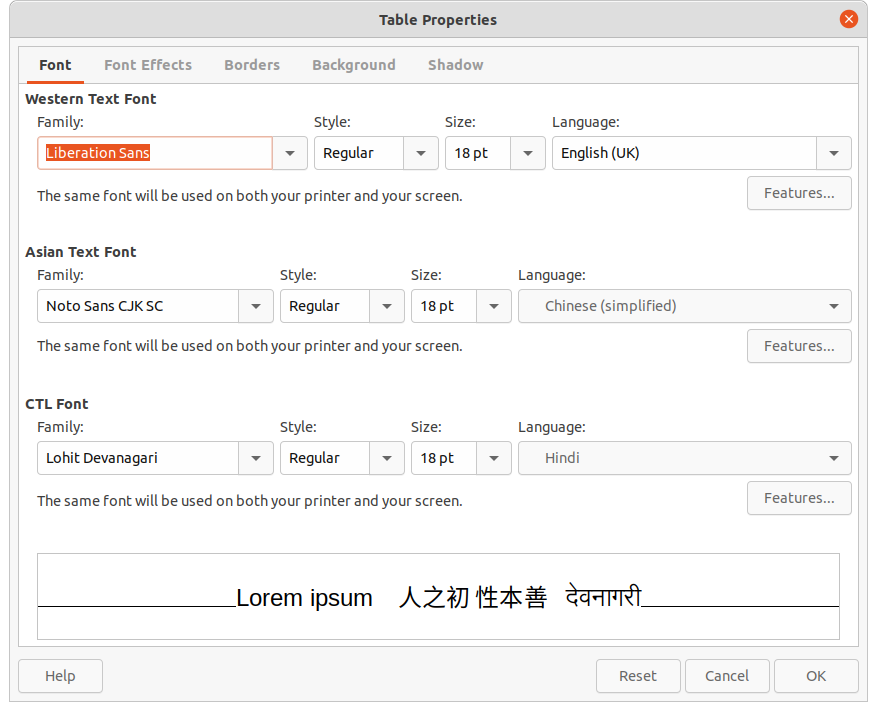
The formatting options on each dialog page are as follows:
Font (Figure 38) – select the required Family, Style, Size and Language for text in the table. A sample of the font selected is displayed in the preview box. See the Writer Guide for more information on fonts.
Font Effects (Figure 39) – select the required Font Color, Text Decoration and Effects for the text in the table. A sample of the font effects applied to the text is displayed in the preview box. See the Writer Guide for more information on font effects.
Borders (Figure 40) – select the required Line Arrangement, Line and Padding for the table and cell borders. These options are similar to the tools Border Style, Border Color and Borders on the Table toolbar. See Chapter 4, Changing Object Attributes for more information on the lines used for table and cell borders.
Background (Figure 41) – select a background as the area fill for the table and/or selected cells. This dialog page provides the same functions as Area Style/Filling tools on the Table toolbar. See Chapter 4, Changing Object Attributes for more information on area style and filling used for table and cell backgrounds.
Shadow (Figure 42) – adds a shadow to the table. The options adjust the look and position of the shadow. See Chapter 4, Changing Object Attributes for more information on table shadows.
Figure 39: Table Properties dialog - Font Effects page
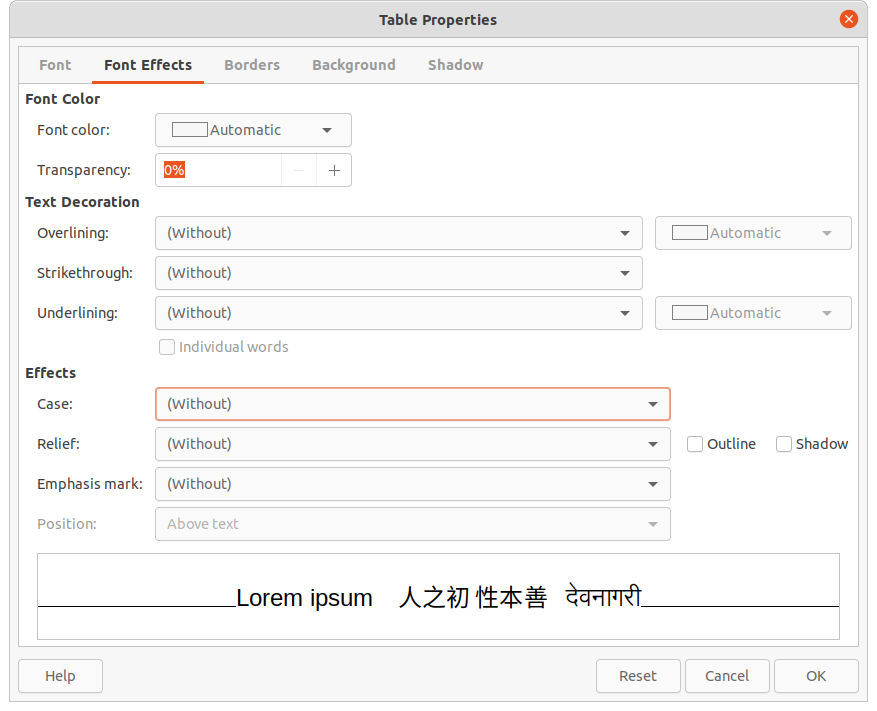
Figure 40: Table Properties dialog - Borders page
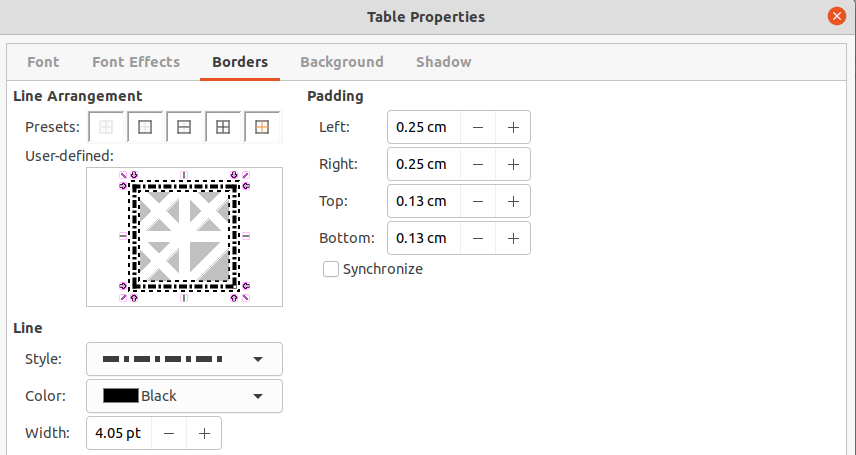
Figure 41: Table Properties dialog - Background page
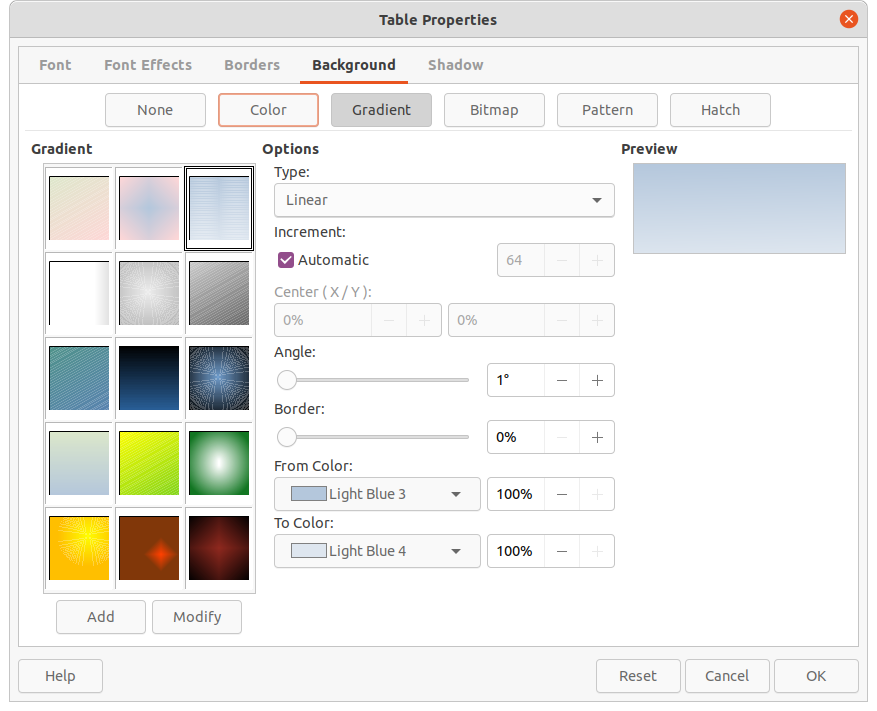
Figure 42: Table Properties dialog - Shadow page
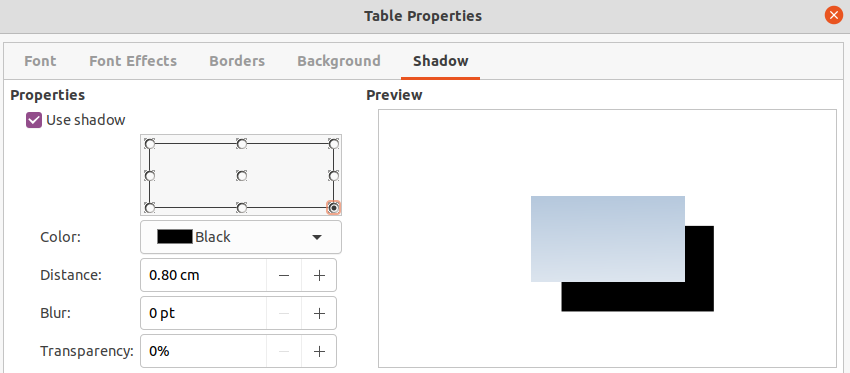
Figure 43: Position and Size dialog
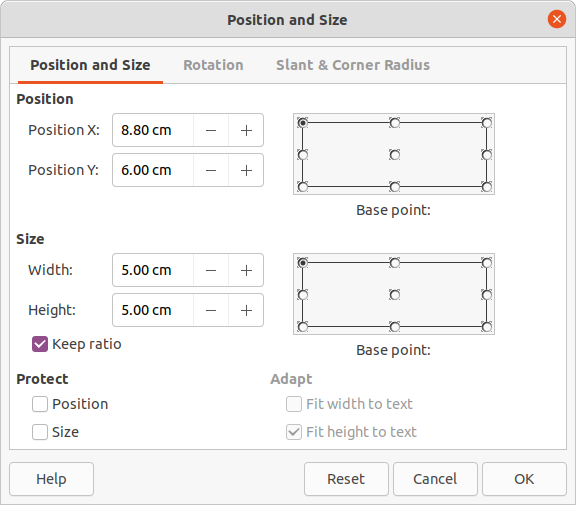
Tables are placed into boxes when created and are treated just like any other object in a drawing. After selecting the table, use one of the following methods to change table position and size. See “Text boxes” on page 1 and Chapter 3, Working with Objects for more information positioning and resizing.
Click on the table border and drag the table to a new position.
Click on a selection handle and drag it to change the table size.
Open the Position and Size dialog and use the options available on the Position and Size page (Figure 43). The options available in the Rotation, and Slant & Corner Radius pages cannot be used for a table.
After selecting the table, use one of the following methods to open the Position and Size dialog:
Right-click on the table and select Position and Size from the context menu.
Go to Format > Position and Size on the Menu bar.
Use the keyboard shortcut F4.
Note
When the size of a table box is changed, the table and cell contents also increases or decreases in size to match the box size.
Make sure the table is selected and the selection handles are visible on the table border, then delete the table using one of the following methods:
Go to Format > Table > Delete Table on the Menu bar.
Select Delete Table on the Table toolbar.
Right-click on the table and select Delete > Delete Table from the context menu.
Click in a table cell, then delete the table row or column using one of the following methods. Make sure the table selection handles are NOT displayed.
Go to Format > Table > Delete Row or Delete Column on the Menu bar
Select Delete Row or Delete Column on the Table toolbar.
Right-click and select Delete > Delete Row or Delete Column from the context menu.
Delete cell contents in a table as follows:
1) Select the cell or cells.
2) Press the Delete or Backspace key on the keyboard.
Fields allow for the automatic insertion of text into a drawing. Fields are commonly used when creating templates and drawing masters. For more information on templates and master drawings, see Chapter 11, Advanced Drawing Techniques.
A text box is created when a field is inserted into the center of a drawing and can be repositioned just like any other text box. See “Text boxes” on page 1 for more information.
1) Go to Insert > Field on the Menu bar and select the type of field.
2) If necessary, position and resize the field text box.
3) If necessary, format the text used for the field information. See “Formatting text” on page 1 for more information.
The fields available in Draw are as follows:
Date (fixed) – inserts the current date into a drawing as a fixed field. The date is not automatically updated. Available date formats depend on the language setting in Tools > Options > Language Settings > Language. Right-click on the date field and select the required date format from the context menu.
Date (variable) – inserts the current date into a drawing as a variable field. The date is automatically updated each time the file is opened. Available date formats depend on the language setting in Tools > Options > Language Settings > Language. Right-click on the date field and select the required date format from the context menu.
Time (fixed) – inserts the current time into a drawing as a fixed field. The time is not automatically updated. Available time formats depend on the language setting in Tools > Options > Language Settings > Language. Right-click on the time field and select the required time format from the context menu.
Time (variable) – inserts the current time into a drawing as a variable field. The time is automatically updated each time the file is opened. Available time formats depend on the language setting in Tools > Options > Language Settings > Language. Right-click on the time field and select the required time format from the context menu.
Author – inserts the first and last names of the author of the drawing. This information is taken from values entered in the LibreOffice user data. To modify this information go to Tools > Options > LibreOffice > User Data.
Page Number – inserts the page number into the current drawing. Alternatively, go to Insert > Page Number on the Menu bar. If a page number is to be added to every page in the drawing, go to View > Master on the Menu bar and insert the page number field.
Page Title – inserts the page title. The default name is Page # if the page has not been renamed.
Page Count – inserts the total number of pages in a drawing.
File Name – inserts the name of the file used for the drawing. The file name only appears after the file has been saved.
When inserting text that can be used as a hyperlink (for example, a website address or URL), Draw formats it automatically, creating the hyperlink and applying color and underlining.
Tip
To prevent LibreOffice from automatically turning website addresses or URLs into hyperlinks, go to Tools > AutoCorrect Options > Options on the Menu bar and deselect URL Recognition.
Tip
To change the color of hyperlinks, go to Tools > Options > LibreOffice > Application Colors, scroll to Unvisited links and/or Visited links, select the checkboxes, then select new colors from the color palettes for the links and click OK. Note this color change changes the color for all hyperlinks across all components of LibreOffice.
Figure 44: Hyperlink dialog
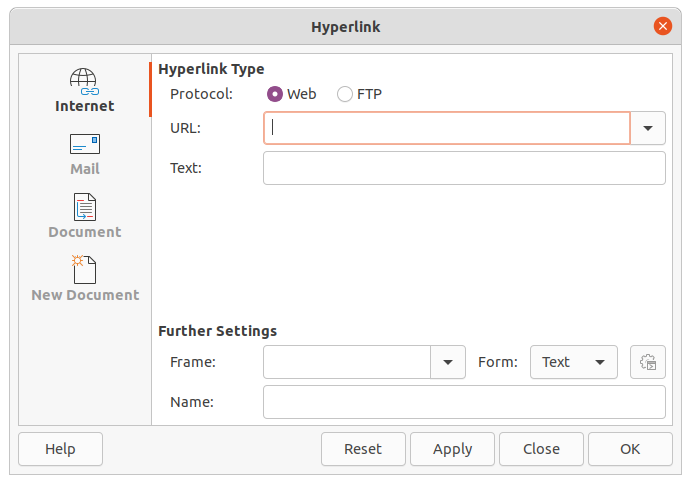
1) Click in the text box at the required position for the hyperlink.
2) Go to Insert > Hyperlink on the Menu bar, or use the keyboard shortcut Ctrl+K to open the Hyperlink dialog (Figure 44).
3) Select the type of hyperlink required and the required options. See “Hyperlink types” below for hyperlink types and the options available for each type.
4) Click Apply to insert the hyperlink and save your selections. If several hyperlinks are being created, click Apply after inserting each hyperlink.
5) Click OK to save the changes and close the Hyperlink dialog.
On the left side, select one of the four types of hyperlinks. The dialog changes according to the type of hyperlink selected.
Internet – select whether the link is Web or FTP. Enter the required web address (URL) and any necessary text.
Mail – enter the recipient details and subject for the email.
Document
Enter the file path for the document, or click on Open File to open a file browser. Leave this blank if the link is to a target in the same drawing.
Specify a target, for example. a specific page in a drawing. Click on Target to open the Target in Document dialog, where a target can be selected. If the name of the target is known, enter its name into the box.
If necessary, enter the URL of the document. These hyperlinks are commonly referred to as a bookmark.
New Document – creates a hyperlink to a new document.
Select Edit now to edit the newly created document immediately, or Edit later to create a new document and edit it later.
Select the type of document to create (text, spreadsheet, etc.).
Click on Select path to open a file browser and navigate to the folder where the new document is going to be saved.
The Further Settings section in the Hyperlink dialog is common to all the hyperlink types, although some options are more relevant to some types of links.
Frame – determines how the hyperlink opens. This applies to documents that open in a Web browser.
Form – specifies if the link is to be presented as text or as a button.
Text – specifies what text is visible to the user.
Name – applicable to HTML documents. It specifies the text added as a NAME attribute in the HTML code behind the hyperlink.
1) Select the hyperlink.
2) Go to Edit > Hyperlink on the Menu bar to open the Hyperlink dialog.
3) Make editing changes using the available options, then click Apply when done. If several hyperlinks are to be edited, click Apply after editing each hyperlink.
4) Click OK to save the changes and close the dialog.
An image map defines areas of the image (called hotspots) associated with a URL (a web address or a file on the computer). Hotspots are the graphic equivalent of text hyperlinks. In Draw, clicking on a hotspot opens the linked page in the appropriate program (for example, default browser for HTML pages; LibreOffice Writer for ODT files; PDF viewer for PDF files).
Hotspots can be created in various shapes, such as rectangles, ellipses, and polygons, and include several hotspots in the same image. When a hotspot is clicked on, the URL opens in a browser window or frame that has been specified. The text that appears when the cursor hovers over a hotspot can also be specified.
1) Select an image in a drawing to use as a hotspot.
2) Go to Tools > ImageMap on the Menu bar to open the Image Map Editor dialog (Figure 45). The main part of the dialog shows the selected image where hotspots will be defined.
3) Select the type of hotspot area required from the icons at the top of the Image Map Editor dialog – Rectangle, Ellipse, Polygon, Freeform Polygon.
4) Draw the hotspot area onto the selected image.
5) Enter the hyperlink address for the hotspot in the Address text box using the address format: file:///<path>/document_name#anchor_name.
6) Click on Apply to apply the settings.
7) Click on Save to save the image map to a file, then close the Image Map Editor dialog.
Figure 45: Image Map Editor dialog
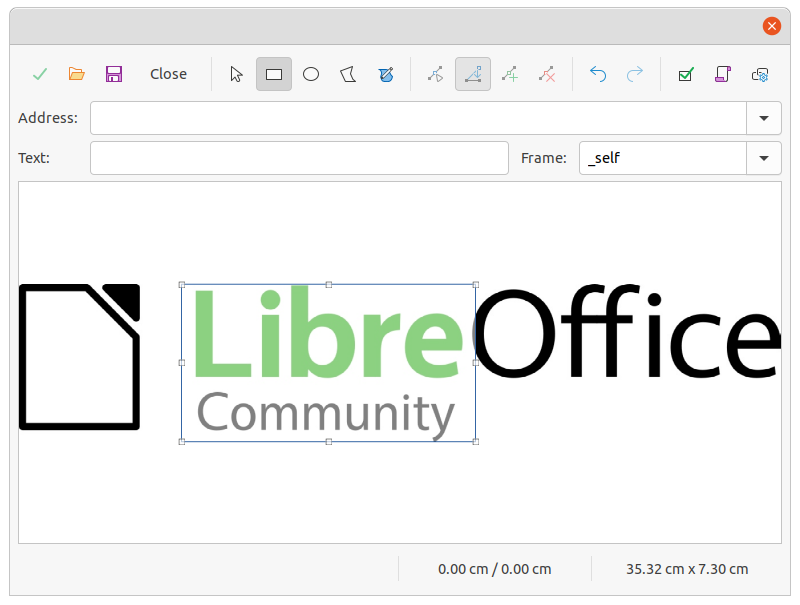
The ImageMap Editor contains the following tools:
Apply – applies the changes.
Open – loads into the Image Map Editor an existing image map in the MAP-CERN, MAP-NCSA or SIP StarView image map file format.
Save – saves the image map in the MAP-CERN, MAP-NCSA or SIP StarView image map file format.
Select – selects a hotspot in the image map for editing.
Rectangle, Ellipse, Polygon, Freeform Polygon – draws a hotspot on the selected image in the shape selected.
Edit Points – change the shape of the selected hotspot by editing the anchor points.
Move Points – move the individual anchor points of the selected hotspot.
Insert Points – adds an anchor point at the selected point on the outline of the hotspot.
Delete Points – deletes a selected anchor point.
Undo – cancels the previous action.
Redo – reapplies the previous cancelled action.
Active – toggles the status of a selected hotspot between active and inactive.
Macro – assign a macro that runs when the hotspot is clicked on.
Properties – define the properties of the selected hotspot.
Address – enter the URL for the file that opens when the selected hotspot is clicked on. The address format to be used: file:///<path>/document_name#anchor_name.
Text – enter the text that is displayed when the cursor rests on the hotspot . If no text is entered, the Address is displayed.
Frame – enter the name of the target frame for the hotspot. Standard frame name can be selected from the drop-down list and used instead.
_blank – opens in a new browser window.
_self – default selection and opens in the current window.
_top – file opens in the topmost frame in the hierarchy.
_parent – file opens in the parent frame of the current frame. If there is no parent frame, the current frame is used.
Graphic view – displays the image map so that the hotspots can be selected and edited.
Tip
The value _self for the target frame will work on the vast majority of the occasions. It is not recommended to use the other values, if available, unless absolutely necessary.
Figure 46: Fontwork Gallery dialog
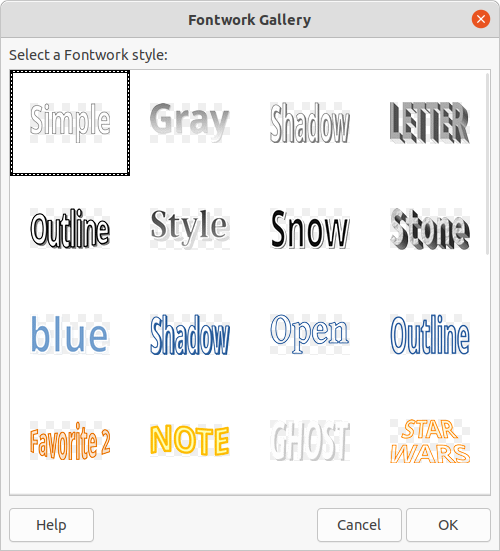
Figure 47: Examples of using Fontwork
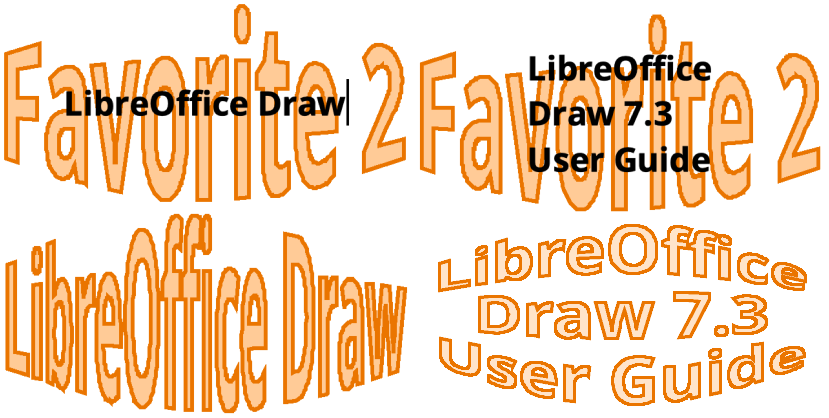
Using Fontwork creates graphical text as objects to make a drawing look more attractive. There are many different settings for Fontwork (line, area, position, size, and more) to match the requirements of a drawing.
Fontwork is also available with the Writer, Calc, and Impress modules of LibreOffice, but there are small differences in the way that each LibreOffice module displays Fontwork.
1) Open the Fontwork Gallery dialog (Figure 46) using one of the following methods.
Go to Insert > Fontwork on the Menu bar.
Click on Insert Fontwork Text on the Standard toolbar.
Click on Insert Fontwork Text on the Fontwork toolbar, if this toolbar is visible.
2) Select a Fontwork style from the dialog and click OK. The selected Fontwork object appears in the center of the drawing and the dialog closes.
3) Double-click on the black text in the Fontwork object to switch on editing mode.
4) Type the required text which replaces the black text in the Fontwork object as shown in Figure 47.
5) Press the Esc key or click outside the selected area to apply the change.
Note
Fontwork creates a single line of text. To create a multi-line Fontwork, press the Enter key to create paragraphs for each line of Fontwork text as shown by the example in Figure 47.
The Fontwork toolbar (Figure 48) becomes visible and active on the workspace when a Fontwork object is selected. If the toolbar is not visible, go to View > Toolbars > Fontwork on the Menu bar.
Figure 48: Fontwork toolbar

Figure 49: Fontwork Shape toolbar

The following tools are available for editing a Fontwork object.
Insert Fontwork Text – opens the Fontwork Gallery dialog.
Fontwork Shape – changes the shape of the selected object. Click on Fontwork Shape to open a pop-up toolbar and select a Fontwork shape for the available options. The shapes are shown in the Fontwork Shape floating sub-toolbar (Figure 49).
Fontwork Same Letter Heights – changes the height of characters in the selected Fontwork object. Toggles between normal height where the characters have different heights to where all characters have the same height.
Fontwork Alignment – specifies the text alignment within the frame. Options are Left Align, Center, Right Align, Word Justify, and Stretch Justify.
Fontwork Character Spacing – selects the spacing between characters and whether kerning pairs should be used. Options are Very Tight, Tight, Normal, Loose, Very Loose and Custom. For Custom spacing, input a percentage value: 100% is normal character spacing, less than 100% character spacing is tighter, and more than 100% character spacing is looser.
Toggle Extrusion – converts the Fontwork object into a 3D shape using extrusion. See Chapter 7, 3D Objects for more information.
A Fontwork object can be treated like any other object in Draw. It can be resized, rotated, skewed, slanted, flipped, and so on. For more information on modifying a Fontwork object, see Chapter 3, Working With Objects, Chapter 4, Changing Object Attributes and Chapter 5, Combining Multiple Objects.
Although Fontwork consists of text, only minimal text formatting options can be used with Fontwork text, for example font type, font size, Bold, or Italic.
Some of the Fontwork shapes can be modified. For example, to change the angles of trapezoid or parallelogram basic shapes by moving the dot that is displayed along with the selection handles.